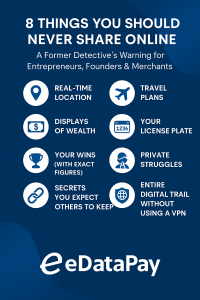eDataPay's Complete Guide to 18 B2B Ecommerce Best Practices
The eDataPay’s merchant Guide with the 18 B2B Ecommerce Best Practices

Running a successful B2B ecommerce business in today’s competitive landscape requires a strategic approach and a deep understanding of best practices. At eDataPay, we’ve compiled a comprehensive guide to help you optimize your site, increase sales, and enhance customer loyalty. Whether you’re new to the B2B ecommerce world or looking to improve your existing operations, these strategies will set you on the path to success.
Best Practices for Designing a B2B eCommerce Website · Understanding shopping behavior by understanding the customer pain points ·
if you’re ready to take your B2B business to new heights, keep reading to the end!
The B2B Ecommerce sales
B2B ecommerce involves the online buying and selling of goods and services between businesses. This can encompass physical products, raw materials, and digital services, often utilizing payment methods such as credit cards and wire transfers.
Our Key Differences between B2B and B2C Ecommerce
It can occasionally be difficult to distinguish between B2B and B2C due to the size of the eCommerce market.
Target Customer: B2B eCommerce purchases are intentional and logical ,B2B focuses on business-to-business transactions and the business owners, while B2C caters to individual consumers.
Order Sizes and Frequency: B2B orders are typically larger and more frequent, often in bulk quantities.
Payment Terms: B2B transactions often involve more complex payment terms, including longer credit periods.
Payment Methods: Wires, Push ACH, Zelle, UPI, Commercial Debit cards, B2B buyers prefer ACH payments, wire transfers, and credit cards, while B2C customers lean towards credit cards and digital wallets.
Buying cycles
The B2B market is characterized by prolonged and complex buying cycles.
Product Offerings: B2B ecommerce often deals with specialized and complex products compared to B2C.
Pricing: B2B pricing is often negotiable based on factors like order volume, whereas B2C pricing is typically fixed.
Decision-Making Process: B2B purchasing choices are made by teams of people. B2B purchases involve a more intricate decision-making process with multiple approvals and customization options, contrasting the more straightforward B2C impulse buying. In business-to-consumer transactions, a single person makes the decision to buy, typically in order to satisfy an emotional need or a single want.
18 B2B ECOMMERCE BEST PRACTICES
These several suggestions for the top B2B eCommerce strategies that can assist you in expanding your B2B eCommerce business:
- Implement Security Measures
Protecting customer data and preventing fraud should be paramount. Partner with a compliant payment service provider like eDataPay, offering encryption, advanced fraud protection, and PCI DSS compliance.
- Build an Effective Search Function
Enhance the user experience with an intuitive search function. Include category filters, autocomplete, and keyword optimization for efficient product discovery.
- Make Your Checkout Process Fast and Frictionless
Streamline the checkout process by minimizing steps, offering transparent pricing, and providing multiple payment and shipping options. Consider a single-page checkout or a progress bar for multi-page checkouts.
- Make Reordering Easy
Simplify reordering for repeat customers by saving their payment and shipping information. Enable bulk ordering options to expedite the process.
- Offer Multiple Payment Options
Diversify payment methods to cater to customer preferences, enhancing trust and conversion rates. eDataPay offers a wide range of B2B payment methods for global customers.
- Provide Quality Customer Service
Timely, knowledgeable, and multi-channel customer support builds trust and loyalty. Go the extra mile to exceed customer expectations.
- Utilize Automation
Leverage automation tools to streamline processes, from order fulfillment to marketing. AI-based automation can identify customer trends and personalize the experience.
- Leverage Customer Insights
Collect and analyze customer data to target marketing efforts effectively, optimize your website, and enhance customer relationships.
- Set & Track KPIs
Establish relevant KPIs to measure the success of your ecommerce operations, focusing on conversion rate, average order value, customer retention, and acquisition costs.
- Invest in a Responsive Design
Opt for responsive design to ensure a seamless user experience across various devices. It not only improves customer satisfaction but also boosts search engine rankings.
- Optimize Product Descriptions and Images
Invest in high-quality product images and detailed descriptions. Clear visuals and comprehensive information help customers make informed decisions, reducing returns and enhancing the shopping experience.
- Implement Personalization
Leverage customer data to provide personalized product recommendations, content, and offers. Personalization enhances engagement, increases average order value, and fosters customer loyalty.
- Streamline Inventory Management
Efficient inventory management prevents overselling and stock outs. Implement real-time inventory tracking and automation to ensure accurate product availability information.
- Prioritize Mobile Optimization
With a growing number of B2B buyers using mobile devices, ensure your website is mobile-responsive. Optimize the mobile experience to cater to this demographic effectively.
- Enhance Content Marketing
Create valuable and informative content such as blogs, videos, and guides relevant to your industry. Establish your brand as an authority, attracting and retaining customers.
- Expand Your Product Catalog
Regularly assess market demand and consider expanding your product offerings. Diversification can open new revenue streams and attract a broader customer base.
- Invest in Sustainable Practices
Sustainability is a growing concern for B2B buyers. Implement eco-friendly practices in your supply chain and product offerings to align with sustainability trends.
- Offer Transparent Shipping and Returns
Clearly communicate shipping costs and delivery times to customers. A transparent returns policy builds trust and can influence purchase decisions.
By incorporating these additional best practices into your B2B ecommerce strategy, you’ll further strengthen your position in the market and better meet the evolving needs of your customers.
B2B ECOMMERCE MARKETING TIPS
To effectively market your B2B ecommerce business:
- Social Media especially LinkedIn
- Utilize content marketing to establish authority and trust.
- Focus on SEO to improve search engine visibility.
- Adopt a multi-channel marketing strategy, including email, social media, and paid advertising.
- Encourage user-generated content through reviews and testimonials.
- Develop a loyalty program to reward and retain customers.
- Use retargeting ads to bring visitors back to your site.
- Harness data and analytics to refine your marketing strategies.
- Accept Payments with eDataPay
eDataPay offers a secure, compliant, and versatile payment solution for B2B ecommerce businesses. Accept credit cards, debit cards, ACH payments, and more with ease. Customize your checkout page, manage payments, and access detailed reports through the user-friendly eDataPay gateways like the NMI, ACI, eData Bridge Gate, Authorize.net and more Dashboards. Our robust security measures, including PCI DSS compliance and 3D Secure 2.0, protect your transactions.
In conclusion, the B2B ecommerce landscape is competitive, but by implementing these best practices and partnering with eDataPay for seamless payments, you can stay ahead of the curve and meet the evolving demands of B2B buyers. Get started with eDataPay today and elevate your B2B ecommerce business to new heights!
To conclude,
These are just a few of the essential B2B eCommerce strategies for B2B Ecommerce Business with eDataPay.
By following these tips, you can ensure that your business is well-prepared to compete in the ever-changing online marketplace.
In a rapidly evolving B2B ecommerce environment, staying ahead of the competition requires more than just a digital presence. It demands a commitment to excellence in every aspect of your operation. By implementing the 10 B2B ecommerce best practices outlined in this guide and partnering with eDataPay for secure and efficient payment processing, you’re well-equipped to meet the ever-growing demands of B2B buyers.
As you focus on enhancing your site’s security, user experience, and customer service, eDataPay ensures that your payment processing remains reliable, compliant, and hassle-free. Our commitment to PCI DSS compliance, robust fraud protection, and support for a wide range of payment methods allows you to provide a seamless payment experience for your global customers.
The B2B ecommerce journey is ongoing, and adaptation is key. Continuously monitor your KPIs, analyze customer data, and refine your strategies to align with market trends and evolving customer expectations. With eDataPay as your payment processing partner, you have the foundation to build a thriving B2B ecommerce business.
Ready to take your B2B ecommerce business to the next level? Join forces with eDataPay and discover how our payment solutions can enhance your customer experience, boost conversions, and drive loyalty. Get started with eDataPay today, and together, we’ll navigate the dynamic world of B2B ecommerce, ensuring your success in the digital marketplace.
Contact eDataPay at www.eDataPay.com or by calling +1-561-395-9554 to start a trip where your payment problems become opportunities and your business soars to new heights. Your story of success starts with eDataPay.
Contact
https://www.facebook.com/edatapay









